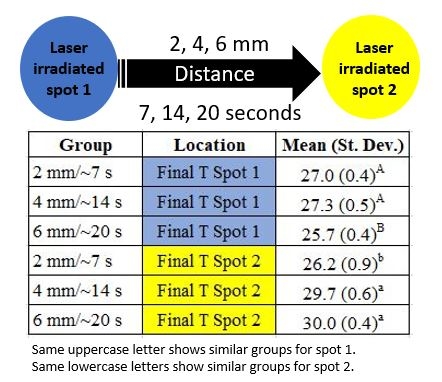IADR Abstract Archives
In-Line Laser Scanning Method Through an YSZ Ceramic: Thermal Effect
Objectives: The aim of this research was to investigate the thermal effect of the Er,Cr:YSGG laser using a line-scanning method at different distances through an YSZ ceramic.
Methods: Slices (~1 mm thick) were fabricated from an YSZ block (IPS e.max ZirCAD, Ivoclar Vivadent) and sintered using a high temperature furnace (Sintramat, Ivoclar Vivadent). Samples were divided into 3 groups (n=10 per group) according to the distance/time the laser traveled: 2 mm/~7 s, 4 mm/~14 s, and 6 mm/~ 20 s. Each sample was irradiated by the Er,Cr:YSGG laser (Waterlase MD™, Biolase) at 1 W and 20 pulses per second and without irrigation using a line scanning method. Two spots parallel to each other were marked at 2, 4, and 6 mm apart on the YSZ surface, and a line was then scanned over the surface. The MG6 tip was held perpendicularly to the ceramic surface while the temperature was measured in the two spots according to the proposed distances, by placing two thermocouples type K in the alternate side of the ceramic structure. The base and final T was recorded in Celsius (°C) with a digital thermometer (OMEGA HH506R) in each of the two spots that were lasered. The base T was measured when the laser was turned on and the final T after the test distance/time.
Results: One-way ANOVA showed that there are significant differences (p=<0.001) when comparing the temperature difference between the base temperature in spot 1 (4 mm/~14 s: 27.3 ± 0.5, 6 mm/~20 s: 25.7 ± 0.4) and the final T in spot 2 (2 mm/~7 s: 26.2 ± 0.9; 4 mm/~14 s: 29.7 ± 0.6, 6 mm/~20 s: 30.0 ± 0.4) at any distance, except when the laser traveled at 2 mm (2 mm/~7 s: 27.0 ± 0.4; p=0.239). There were also significant differences in the final T at 2 mm (p=0.033), 4 mm (p=<0.001) and 6 mm (p=<0.001) in spot 1 and 2.
Data on the difference in the final T between one spot and the other, as a function of the distance/time, is presented in the Figure.
Conclusions: Based on the final T results, as the laser moves from one spot to the next one, at distances greater than or equal to 4 mm, the irradiated area experiences a reduction in T. The thermal effect of the laser using the scanning method through the YSZ ceramic do not reach the adverse T to the dental pulp.
Methods: Slices (~1 mm thick) were fabricated from an YSZ block (IPS e.max ZirCAD, Ivoclar Vivadent) and sintered using a high temperature furnace (Sintramat, Ivoclar Vivadent). Samples were divided into 3 groups (n=10 per group) according to the distance/time the laser traveled: 2 mm/~7 s, 4 mm/~14 s, and 6 mm/~ 20 s. Each sample was irradiated by the Er,Cr:YSGG laser (Waterlase MD™, Biolase) at 1 W and 20 pulses per second and without irrigation using a line scanning method. Two spots parallel to each other were marked at 2, 4, and 6 mm apart on the YSZ surface, and a line was then scanned over the surface. The MG6 tip was held perpendicularly to the ceramic surface while the temperature was measured in the two spots according to the proposed distances, by placing two thermocouples type K in the alternate side of the ceramic structure. The base and final T was recorded in Celsius (°C) with a digital thermometer (OMEGA HH506R) in each of the two spots that were lasered. The base T was measured when the laser was turned on and the final T after the test distance/time.
Results: One-way ANOVA showed that there are significant differences (p=<0.001) when comparing the temperature difference between the base temperature in spot 1 (4 mm/~14 s: 27.3 ± 0.5, 6 mm/~20 s: 25.7 ± 0.4) and the final T in spot 2 (2 mm/~7 s: 26.2 ± 0.9; 4 mm/~14 s: 29.7 ± 0.6, 6 mm/~20 s: 30.0 ± 0.4) at any distance, except when the laser traveled at 2 mm (2 mm/~7 s: 27.0 ± 0.4; p=0.239). There were also significant differences in the final T at 2 mm (p=0.033), 4 mm (p=<0.001) and 6 mm (p=<0.001) in spot 1 and 2.
Data on the difference in the final T between one spot and the other, as a function of the distance/time, is presented in the Figure.
Conclusions: Based on the final T results, as the laser moves from one spot to the next one, at distances greater than or equal to 4 mm, the irradiated area experiences a reduction in T. The thermal effect of the laser using the scanning method through the YSZ ceramic do not reach the adverse T to the dental pulp.

